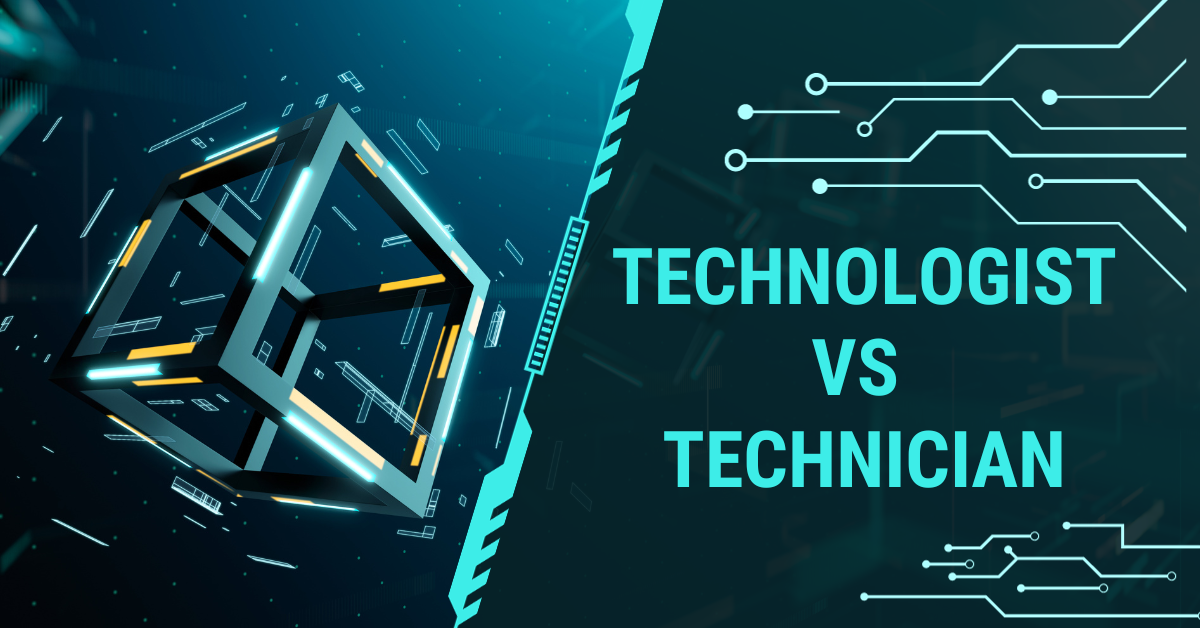16 Nov

What Is the Difference Between a Technologist and a Technician?
In the realm of technology-driven professions, the terms “technologist” and “technician” are often used interchangeably, creating confusion about their specific roles and responsibilities.
While both positions contribute significantly to the technological landscape, they embody distinct skill sets, educational backgrounds, and job functions. In this comprehensive analysis, we will delve into the nuanced differences between a technologist and a technician, shedding light on their unique contributions to various industries.
Defining Technologists and Technicians
Technologist
A technologist is an expert in a specific field of technology, possessing a comprehensive understanding of theoretical principles and practical applications. Unlike technicians, technologists are generally involved in the design, development, and implementation of technological solutions.
Their role extends beyond the day-to-day operational aspects, as they are often responsible for crafting strategies, conducting research, and making decisions that impact the overall technological infrastructure.
Educational Background
Technologists typically hold a bachelor’s or master’s degree in a specialized field, such as information technology, engineering, or computer science. Their education emphasizes a broader understanding of theoretical concepts, allowing them to innovate and contribute to the advancement of technology.
Job Functions
1. Research and Development
Technologists engage in extensive research to identify emerging trends and technologies. They contribute to the development of new products and solutions that push the boundaries of what is currently possible.
2. Strategic Planning
Technologists play a crucial role in devising strategic plans for implementing technology within an organization. This includes assessing current technological needs, anticipating future requirements, and aligning technology with business goals.
3. Project Management
Technologists often take on leadership roles in project management, overseeing the entire lifecycle of a technological project from conception to completion. Their responsibilities include budgeting, resource allocation, and team coordination.
Technician
On the other hand, a technician is a hands-on professional primarily focused on the practical implementation and maintenance of technology. Technicians are instrumental in ensuring that technological systems operate smoothly and efficiently. Their expertise lies in troubleshooting issues, repairing equipment, and providing technical support to end-users.
Educational Background
Technicians usually hold an associate degree or a certification in a specific technology-related field. Their education is more practical and hands-on, emphasizing the skills needed for the day-to-day tasks associated with technology operations.
Job Functions
1. Installation and Maintenance
Technicians are responsible for installing and maintaining various technological systems, including hardware and software components. This involves routine inspections, updates, and repairs.
2. Troubleshooting
When technical issues arise, technicians are the first line of defense. They use their problem-solving skills to diagnose and fix problems efficiently, minimizing downtime for organizations.
3. Technical Support
Technicians provide essential support to end-users, assisting them with technical problems and inquiries. This may involve responding to helpdesk tickets, conducting remote troubleshooting, or offering guidance over the phone.
Bridging the Gap Collaboration in the Technological Landscape
While technologists and technicians operate in different spheres of the technology landscape, their roles are complementary. A seamless collaboration between these professionals is crucial for the success of any organization that relies on technology.
Collaborative Workflow
1. Planning and Design
Technologists lay the groundwork by creating strategic plans and designing technological solutions that align with organizational goals. They consider factors such as scalability, security, and innovation.
2. Implementation
Technicians take the lead in implementing the solutions designed by technologists. This involves configuring hardware, installing software, and ensuring that the technology functions as intended.
3. Feedback Loop
Communication between technologists and technicians is vital for continuous improvement. Technicians provide valuable insights into the practical challenges and successes of implemented solutions, informing future strategic decisions made by technologists.
Case Studies: Real-world Applications
Case Study 1 Healthcare Industry
In a hospital setting, a healthcare technology technologist may focus on designing and implementing an integrated electronic health record system. Meanwhile, healthcare technology technicians would be responsible for the day-to-day maintenance of the system, ensuring that medical staff can access patient information seamlessly.
Case Study 2 Information Technology Services
In an IT services company, an IT technologist might lead the development of a new cloud-based infrastructure to enhance efficiency. IT technicians would then take charge of installing and maintaining the hardware and software required for the new system, providing ongoing technical support to clients.
Future Trends Evolving Roles in a Dynamic Landscape
As technology continues to advance, both technologists and technicians will need to adapt to emerging trends. Artificial intelligence, cybersecurity, and the Internet of Things are just a few areas reshaping the technological landscape.
The Role of Technologists in Innovation
Technologists will increasingly find themselves at the forefront of innovation, leveraging emerging technologies to create new solutions and improve existing ones. The ability to integrate cutting-edge technologies into organizational strategies will become a hallmark of successful technologists.
Technicians and Cybersecurity Challenges
With the rise of cyber threats, technicians will play a critical role in maintaining the security of technological systems. Cybersecurity certifications and training will become integral for technicians as they work to safeguard organizations from evolving cyber risks.
Conclusion
In the dynamic world of technology, the distinction between technologists and technicians is essential for understanding the diverse contributions each makes to the ever-evolving landscape. While technologists drive innovation and strategic planning, technicians ensure the seamless implementation and maintenance of technology.
Together, they form a symbiotic relationship that is fundamental to the success of any organization navigating the complex intersection of technology and business. As we look toward the future, the collaboration between these roles will continue to shape the technological advancements that define our world.




















Find Us On